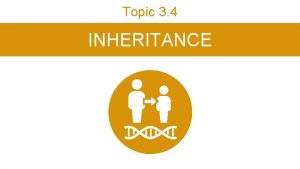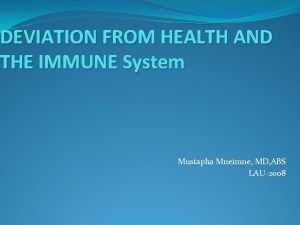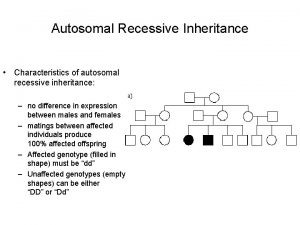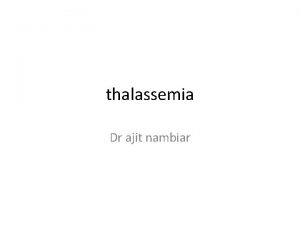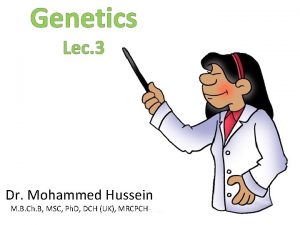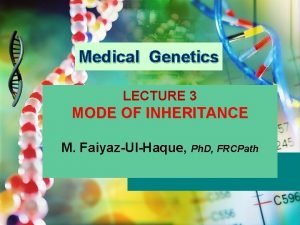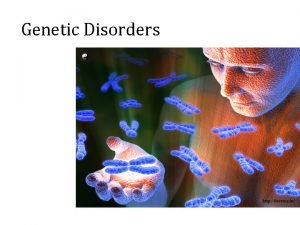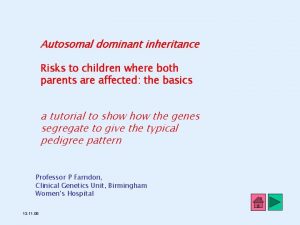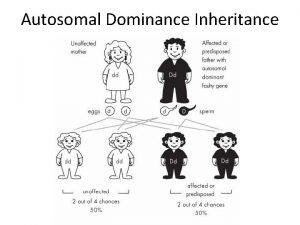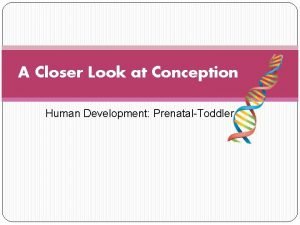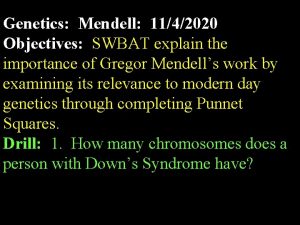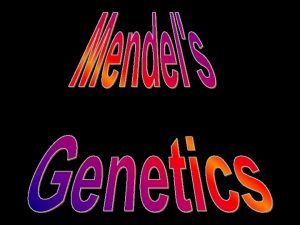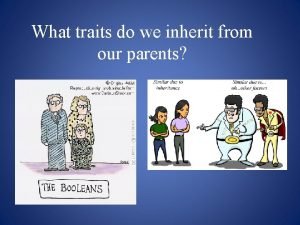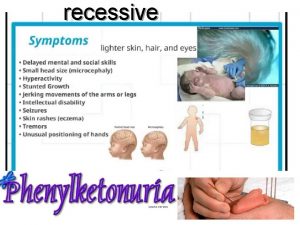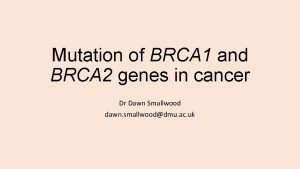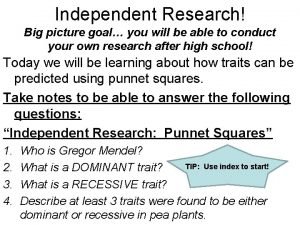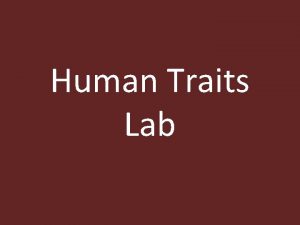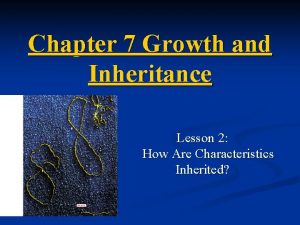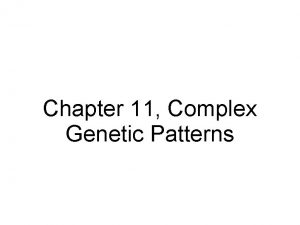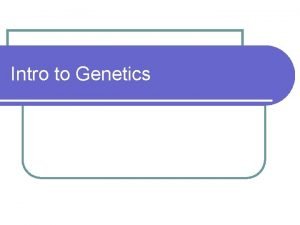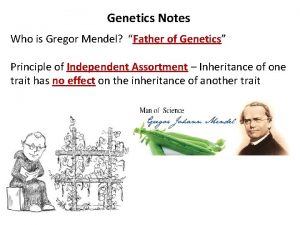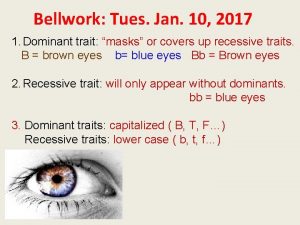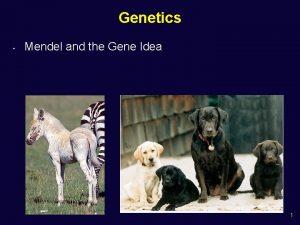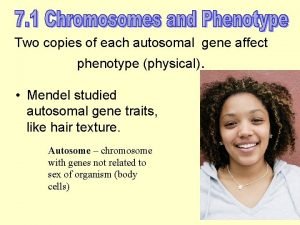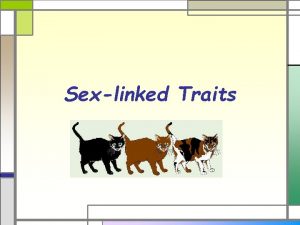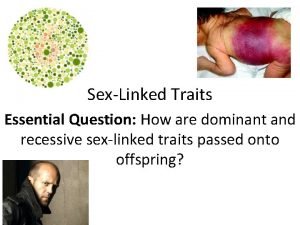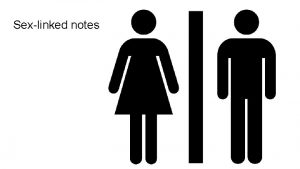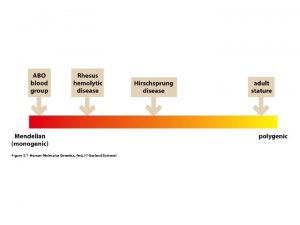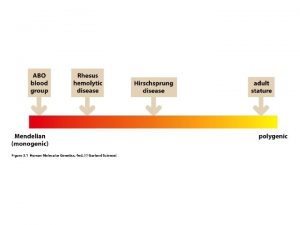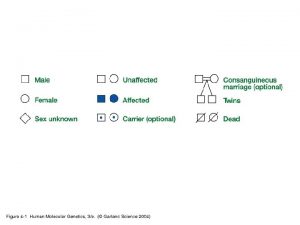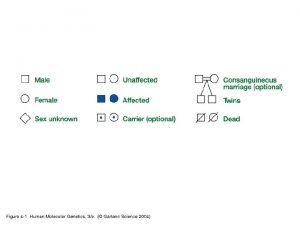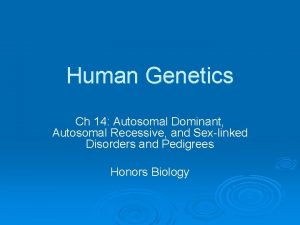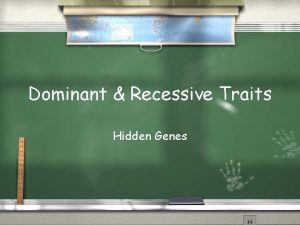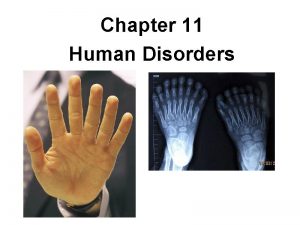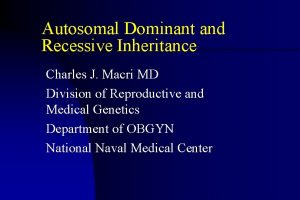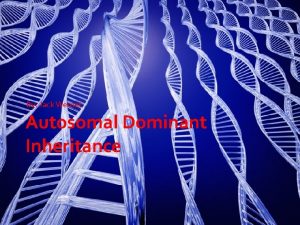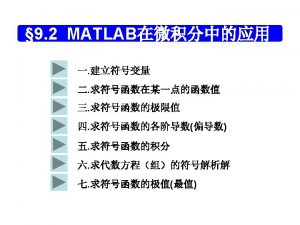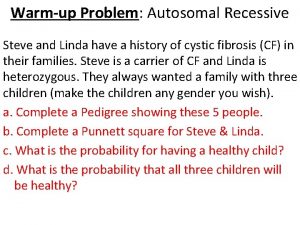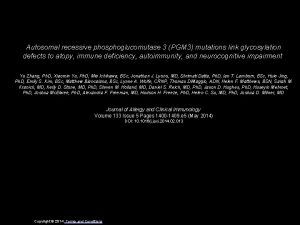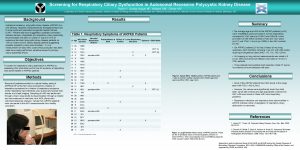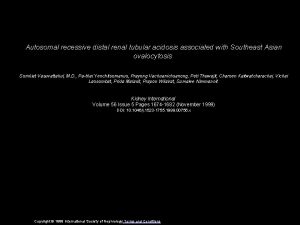1 50 limit 2 autosomal dominant and recessive














































- Slides: 46

유전학 1. 유전자에 의해 지배되는 형질 – 신장 (50% 정도), 외모 (과학의 발달), 수명 (limit), 질병 2. 유전적 특성 – autosomal dominant and recessive 3. 유전형질을 결정하는 물질-DNA (AGCT base pairing ) A-T, G-C pair 4. DNA is double helix (Watson and Click) 5. Central dogma (DNA-RNA-protein)- 실제 기능 -protein 6. 개인간의 유전적 차이 –SNP (single nucleotide polymorphism) 7. Genetic diversity- mutation, chromatin exchange 8. Exon and intron 9. 개인간 면역학적 차이 –MHC; transplantation, blood supply 10. Genetic linkage

Stem cell – 1. embryonic stem cell 2. Adult stem cell 3. Umbilical cord blood stem cell 서래마을- DNA finger printing- 개인간 식별 PCR- basic principle Primer d. NTP DNA polymerase Reverse transcriptase Isolated from virus

Systems of human gastro-intestinal system – stomach/ intestine/liver/pancreas Pulmonary system- lung/bronchioles Cardiovascular system Renal system- kindey/bladder Nerve system Reproduction system Endocrine system Gene cloning- restriction enzyme and DNA ligase

What is Disease? Difference from normal status Infection – bacteria, protozoa, Fungi or virus Genetic disease Chronic disease

Infection by protein Human transmissible spongiform encephalopathy (TSE) Most common disease is Creutzfeldt-Jacob disease (CJD)

Genetic disease Chromosome 1 Contains over 3000 genes Contains over 240 million base pairs, of which ~90% have been determined See the diseases associated with chromosome 1 in the Map. Viewer.

Chromosome 2 Contains over 2500 genes Contains over 240 million base pairs, of which ~95% have been determined See the diseases associated with chromosome 2 in the Map. Viewer Odd eye, deafness

Chromosome 3 Contains approximately 1900 genes Contains approximately 200 million base pairs, of which ~95% have been determined See the diseases associated with chromosome 3 in the Map. Viewer. Blood vessel angioma

Chromosome 4 Contains approximately 1600 genes Contains approximately 190 million base pairs, of which ~95% have been determined See the diseases associated with chromosome 4 in the Map. Viewer

Achondroplasia is a Greek word meaning "without cartilage formation" and is one of the most common causes of dwarfism. The appearance is of short stature with disproportionately short arms and legs and a large head. The characteristic facial features include a prominent forehead and a flattened bridge of the nose. Although this condition can be inherited in an autosomal dominant manner, 80% of cases are due to new, sporadic mutations. Mutations involve the gene encoding fibroblast growth factor receptor 3 (FGFR 3), situated on chromosome 4. Most commonly, a point mutation causes the substitution of arginine for glycine (G 380 R) in the transmembrane region of the receptor. There is growing evidence that mutations of FGF 3 R confer a "gain of function". It is proposed that the normal function of FGFR 3 is to slow down the formation of bone by inhibiting the proliferation of chondrocytes, the cells that produce cartilage. The mutation increases the activity of FGFR 3, severely limiting bone growth. This theory is supported by the knock-out mouse model in which the receptor is absent, and so the negative regulation of bone formation is lost. The result is a mouse with excessively long bones and elongated vertebrae, resulting in a long tail. Achondroplastic mouse models are useful tools in developing potential treatments


Fibrodysplasia ossificans progressiva Fibrodysplasia Ossificans Progressiva (FOP) is an extremely rare genetic disease that causes muscle to be turned into bone. The condition was first reported in the 17 th century by Patin, a French physician, who described a woman who "turned into wood". The wood he described was actually the formation of new bone. FOP is an autosomal dominant condition, but most cases are sporadic. FOP patients have a genetic fault, which means that their bodies cannot switch off the mechanism that grows the skeleton in the womb. Any small injury to connective tissue (muscles, ligaments, and tendons) can result in the formation of hard bone around the damaged site. Children are born with a characteristic malformation of the great toes and begin to develop heterotopic (extra) bone formation during early childhood. Eventually, a second skeleton begins to form that severely restricts mobility. FOP affects 1 of 2 million people. Because of the very small numbers of patients, identifying the mutation(s) causing FOP is difficult. There are several genes that have been implicated in the disease process. For example, when the Noggin gene (NOG) is deleted in mice, the mice are unable to stop the deposition of bone, causing an FOP-like disease. Another gene of interest is the Bone Morphogenic Protein gene (BMP), which Noggin regulates. Proteins encoded by BMP induce bone formation, and one of their roles is to stimulate the formation of the fetal skeleton. In FOP, lymphocytes deliver BMP 4 to areas of damaged muscle, and so initiate bone growth rather than aid tissue repair

Parkinson disease Parkinson disease, first described by James Parkinson in 1817, is a growing national problem, with more than half a million Americans affected at any one time. Most people are over 50 years old when the disease appears, although it can occur in younger patients. It is a neurodegenerative disease that manifests as a tremor, muscular stiffness and difficulty with balance and walking. A classic pathological feature of the disease is the presence of an inclusion body, called the Lewy body, in many regions of the brain. Until relatively recently, Parkinson disease was not though to be heritable, and research was primarily focused on environmental risk factors such as viral infection or neurotoxins. However, a positive family history was gradually perceived to be a risk factor, a view that was confirmed last year when a candidate gene for some cases of Parkinson disease was mapped to chromosome 4. Mutations in this gene have now been linked to several Parkinson disease families. The product of this gene, a protein called alpha-synuclein, is a familiar culprit: a fragment of it is a known constituent of Alzheimer disease plaques. Since alpha-synuclein fragments are implicated in both Parkinson and Alzheimer diseases, there may be shared pathogenic mechanisms between the two, therefore research into one disease may aid understanding of the other. Further avenues for research are also being suggested by cross-species comparisons assisted by database searching. Among others, rats, cows and zebra finches all possess alpha-synuclein; in the rat they play a role in the sense of smell, while in the zebra finch it is thought to be involved in the process of song learning. Further work to elucidate the function of alpha-synuclein in humans, and therefore clues as to the pathology of Parkinson disease, should be assisted by studying

Chromosome 5 Contains approximately 1700 genes Contains approximately 180 million base pairs, of which over 95% have been determined See the diseases associated with chromosome 5 in the Map. Viewer.

Chromosome 6 Contains approximately 1900 genes Contains approximately 170 million base pairs, of which over 95% have been determined See the diseases associated with chromosome 6 in the Map. Viewer.

Chromosome 7 Contains approximately 1800 genes Contains over 150 million base pairs, of which over 95% have been determined See the diseases associated with chromosome 7 in the Map. Viewer. leptin

Multi-genes in Ch 7 IQ is low but they sometimes show talents in music, language

Chromosome 8 Contains over 1400 genes Contains over 140 million base pairs, of which over 95% have been determined See the diseases associated with chromosome 8 in the Map. Viewer.

Chromosome 9 Contains over 1400 genes Contains over 130 million base pairs, of which over 85% have been determined See the diseases associated with chromosome 9 in the Map. Viewer. Philadelphian chromosome Gleevec

Chromosome 10 Contains over 1400 genes Contains over 130 million base pairs, of which over 95% have been determined See the diseases associated with chromosome 10 in the Map. Viewer.

Chromosome 11 Contains approximately 2000 genes Contains over 130 million base pairs, of which over 95% have been determined See the diseases associated with chromosome 11 in the Map. Viewer.

Chromosome 12 Contains over 1600 genes Contains over 130 million base pairs, of which over 95% have been determined See the diseases associated with chromosome 12 in the Map. Viewer.

Chromosome 13 Contains approximately 800 genes Contains over 110 million base pairs, of which over 80% have been determined See the diseases associated with chromosome 13 in the Map. Viewer. Copper transport

Chromosome 14 Contains approximately 1200 genes Contains over 100 million base pairs, of which over 80% have been determined See the diseases associated with chromosome 14 in the Map. Viewer. Chromosome 15 Contains approximately 1200 genes Contains approximately 100 million base pairs, of which over 80% have been determined See the diseases associated with chromosome 15 in the Map. Viewer.

Prader-willi syndrome Angelman syndrome The Same locus, different phenotype

Marfan syndrom

Chromosome 16 Contains approximately 1300 genes Contains approximately 90 million base pairs, of which over 85% have been determined See the diseases associated with chromosome 16 in the Map. Viewer Chromosome 17 Contains over 1600 genes Contains approximately 80 million base pairs, of which over 95% have been determined See the diseases associated with chromosome 17 in the Map. Viewer.

Chromosome 18 Contains over 600 genes Contains over 70 million base pairs, of which over 95% have been determined See the diseases associated with chromosome 18 in the Map. Viewer

Chromosome 19 Contains over 1700 genes Contains over 60 million base pairs, of which over 85% have been determined See the diseases associated with chromosome 19 in the Map. Viewer. Chromosome 20 Contains over 900 genes Contains over 60 million base pairs, of which over 90% have been determined See the diseases associated with chromosome 20 in the Map. Viewer.

Chromosome 21 Contains over 400 genes Contains over 40 million base pairs, of which over 70% have been determined See the diseases associated with chromosome 21 in the Map. Viewer.

Chromosome 22 Contains over 800 genes Contains over 40 million base pairs, of which approximately 70% have been determined See the diseases associated with chromosome 22 in the Map. Viewer

Chromosome X Contains over 1400 genes Contains over 150 million base pairs, of which approximately 95% have been determined See the diseases associated with chromosome X in the Map. Viewer.


Cancer is genetic disease Cancer prone genetic disease Li-Fraumeni syndrome Von Hippel Lindau syndrome Cylindermatosis, Retinoblastoma FAP etc







Benign vs malignancy Growth pattern: local vs invasion and meta Differentiation: well diff vs variable


Genetic alternation Oncogene >Tumor suppressor 1. Rapid cell cycle 2. Resistance against cell death 3. Movement to other site (metastasis ) 4. Generation new blood vessel death



 Autosomal recessive and dominant
Autosomal recessive and dominant Dominant and recessive genes
Dominant and recessive genes Pedigree sumbols
Pedigree sumbols Pedigree only males affected
Pedigree only males affected Immune system structure
Immune system structure Genotype of autosomal dominant
Genotype of autosomal dominant What is hydrops
What is hydrops Autosomal recessive cystic fibrosis
Autosomal recessive cystic fibrosis Autosomal recessive
Autosomal recessive Autosomal recessive
Autosomal recessive Sex linked vs autosomal pedigree
Sex linked vs autosomal pedigree Autosomal dominant punnett square
Autosomal dominant punnett square Leigh syndrome
Leigh syndrome Autosomal dominant
Autosomal dominant Autosome
Autosome Punnett square blood type ab and o
Punnett square blood type ab and o Color blindness punnett square
Color blindness punnett square Dominant and recessive genes
Dominant and recessive genes Dominant and recessive genes
Dominant and recessive genes Bb x bb punnett square
Bb x bb punnett square Phenotype heterozygous
Phenotype heterozygous Hand clasping dominant or recessive
Hand clasping dominant or recessive Is pku dominant or recessive
Is pku dominant or recessive Is brca dominant or recessive
Is brca dominant or recessive Is down syndrome dominant or recessive
Is down syndrome dominant or recessive Are dimples dominant or recessive
Are dimples dominant or recessive Dimple dominant or recessive
Dimple dominant or recessive Roll tongue dominant or recessive
Roll tongue dominant or recessive Can two blues make a brown
Can two blues make a brown Tongue rolling dominant or recessive
Tongue rolling dominant or recessive Is baldness dominant or recessive
Is baldness dominant or recessive Free earlobe vs attached
Free earlobe vs attached Attached vs free earlobes
Attached vs free earlobes What is a inherited trait
What is a inherited trait Is hitchhiker's thumb dominant or recessive
Is hitchhiker's thumb dominant or recessive Are almond eyes dominant
Are almond eyes dominant Widow's peak is dominant to no widow's peak
Widow's peak is dominant to no widow's peak Explain
Explain Genotype and phenotype examples punnett square
Genotype and phenotype examples punnett square Mendel's experimental design
Mendel's experimental design If lclp is negative number, we set the lclp = 0. why?
If lclp is negative number, we set the lclp = 0. why? Natural variations operations management
Natural variations operations management Pengertian limit
Pengertian limit Two copies of each autosomal gene affect
Two copies of each autosomal gene affect Pedigree chart for colour blindness
Pedigree chart for colour blindness Autosomal vs sex linked
Autosomal vs sex linked Is huntington's disease autosomal or sexlinked
Is huntington's disease autosomal or sexlinked

